Page 227 of 322

Service & Appearance Care
Filling Your Tank
The cap is behind a hinged door on the
left side of your vehicle.
Gasoline vapor is highly
flammable. It burns violently,
and that can cause very bad
I injuries. Don’t smoke if you’re
ar gasoline or refueling your
vehicle. Keep sparks, flames, and
smoking materials away from
gasoline.
I
To take off the cap, turn it slowly to the
left (counterclockwise), While refueling, hang
the cap inside the
fuel door.
I
A If you get gasoline on you and
L then something ignites it, you
L.udd be badly burned. Gasoline
can spray out on you if you open
the fuel filler cap too quickly. This
spray can happen if your tank is
nearly
full, and is more likely in
hot weather. Open the fuel filler
cap slowly and wait for any “hiss”
noise to stop. Then unscrew the
cap all the way.
When you put the cap back on, turn
it to
the right until you hear a clicking noise.
m.. 226
If you need a new cap, be sure to
get the right type. Your dealer
get one for you. If you get the
wrong type,
it may not fit or have
proper venting, and your fuel tank
and emissions system
might be
damaged.
ProCarManuals.com
Page 228 of 322
Fuel Door Manual Release
[f your vehicle has a fuel door lock, the
Fuel door can be opened manually
in
;ase of an electrical power failure. To
io so, first open the trunk. The release
mechanism is
on the driver's side of the
vehicle, at the top
of the trunk
2ompartment. Pull the tab to release the
fuel door.
Checking Things Under
the Hood
The following sections tell you how to
check fluids, lubricants and important
parts underhood.
Hood Release
To open the hood, first pull the hood
release handle inside the vehicle.
ProCarManuals.com
Page 232 of 322
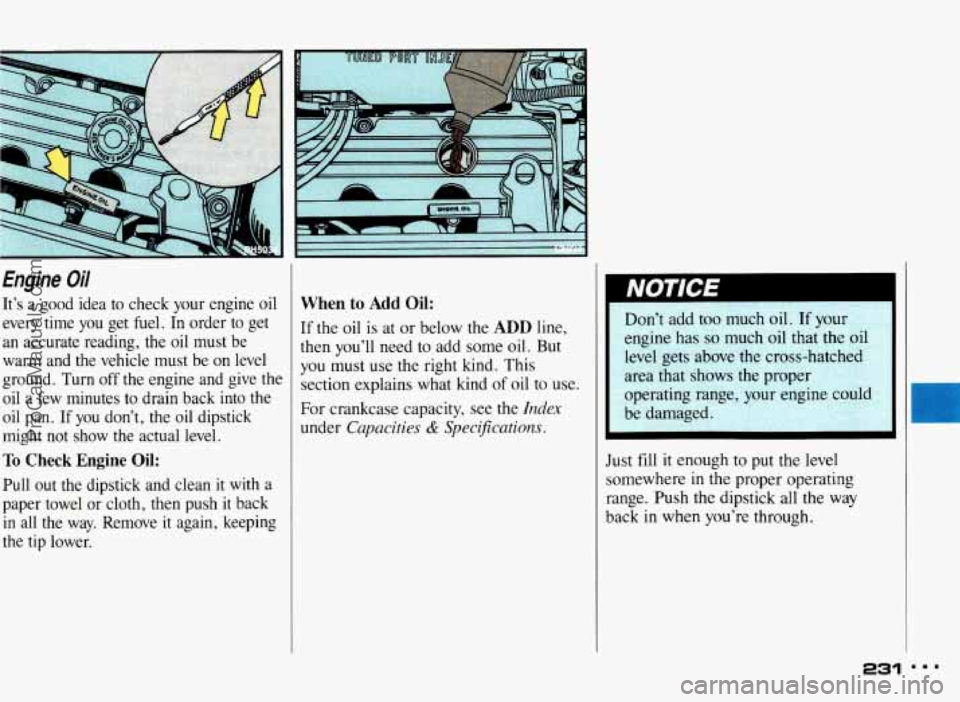
Engine Oil
It’s a good idea to check your engine oil
every time you get fuel. In order to get
an accurate reading, the oil must be
warm and the vehicle must be on level
ground. Turn off the engine and give the
oil
a few minutes to drain back into the
oil pan. If you don’t, the oil dipstick
might
not show the actual level.
To Check Engine Oil:
Pull out the dipstick and clean it with a
paper towel or cloth, then push
it back
in all the way. Remove it again, keeping
the tip lower.
When to Add Oil:
If the oil is at or below the ADD line,
then you’ll need
to add some oil. But
you must use the right kind. This section explains what kind of oil to use.
For crankcase capacity, see the
Zr.z&x
under Capacities & Specijicatiow.
Don’t add too much oil. If your
engine has
so much oil that the oil
level gets above the cross-hatched
area that shows the proper
operating range, your engine could
be damaged.
I
Just fill it enough to put the level
somewhere
in the proper operating
range. Push
the dipstick all the way
back
in when you’re through.
231
ProCarManuals.com
Page 233 of 322
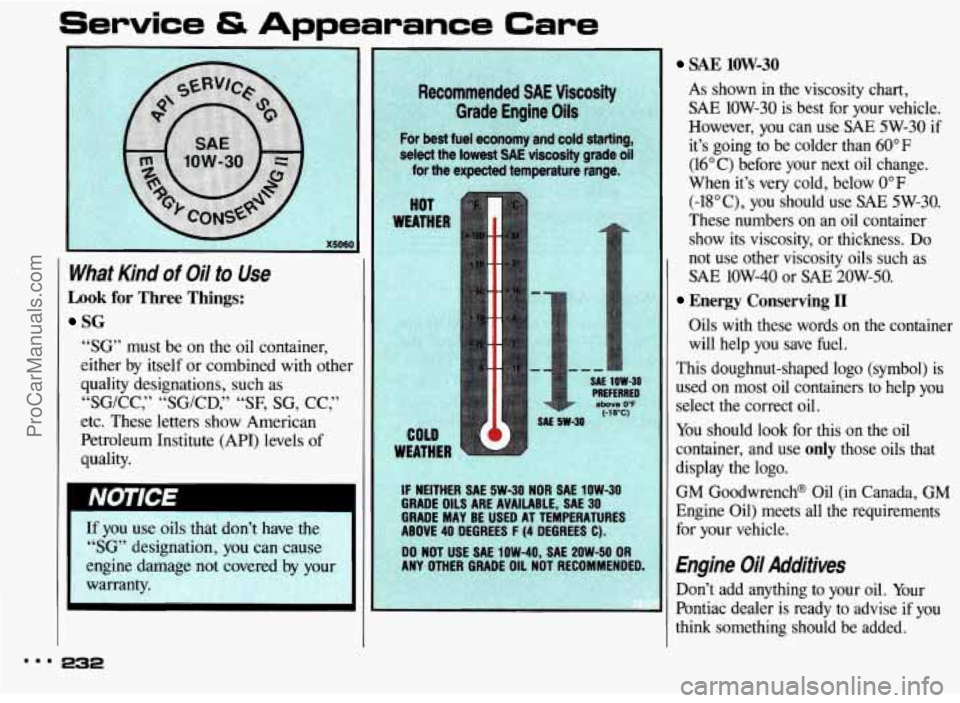
Service tS Appearance Care
What Kind of Oil to Use
Look for Three Things:
SG
“SG” must be on the oil container,
either by itself or combined with other
quality designations, such as
“SGICC,”
“SGICD,” “SF, SG, CC,”
etc. These letters show American
Petroleum Institute (API) levels of
1 quality.
If you use oils that don’t have the
“SG” designation, you can cause
engine damage not covered
by your
warranty.
’,”,, .
For best fuel economy and cold starting,
select the
lowest SAE viscosity grade oil ’;,:;:?,:!
for the expected temperature range,:?$’:&,:, 4 , ,,
IF NEITHER SAE 5W-30 NOR SAE 1OW-30
GRADE OILS ARE AVAILABLE, SAE 30 ’
GRADE MAY BE USED AT TEMPERATURES ’ ,
ABOVE 40 DEGREES F (4 DEGREES C). .,
ANY OTHER GRADE OIL NOT RECOMMENDED.
DO
NOT USE
SAE 1OW-40, SAE 20W-50 OR ’ i’
,,
SAE low-30
As shown in the viscosity chart,
SAE
1OW-30 is best for your vehicle.
However, you can use SAE
5W-30 if
it’s going to be colder than 60°F
(16°C) before your next oil change.
When it’s very cold, below
0°F
(-18”C), you should use SAE 5W-30.
These numbers on an oil container
show its viscosity, or thickness. Do
not use other viscosity
oils such as
SAE 1OW-40 or SAE 20W-50.
Energy Conserving 11
Oils with these words on the container
will help you save fuel.
This doughnut-shaped logo (symbol) is
used on most oil containers to help you select the correct oil.
You should look for this on the oil
container, and use
only those oils that
display the logo.
GM Goodwrench@ Oil (in Canada, GM
Engine Oil) meets all the requirements
for your vehicle.
Engine Oil Additives
Don’t add anything to your oil. Your
Pontiac dealer is ready to advise if you
think something should be added.
... 232
ProCarManuals.com
Page 249 of 322
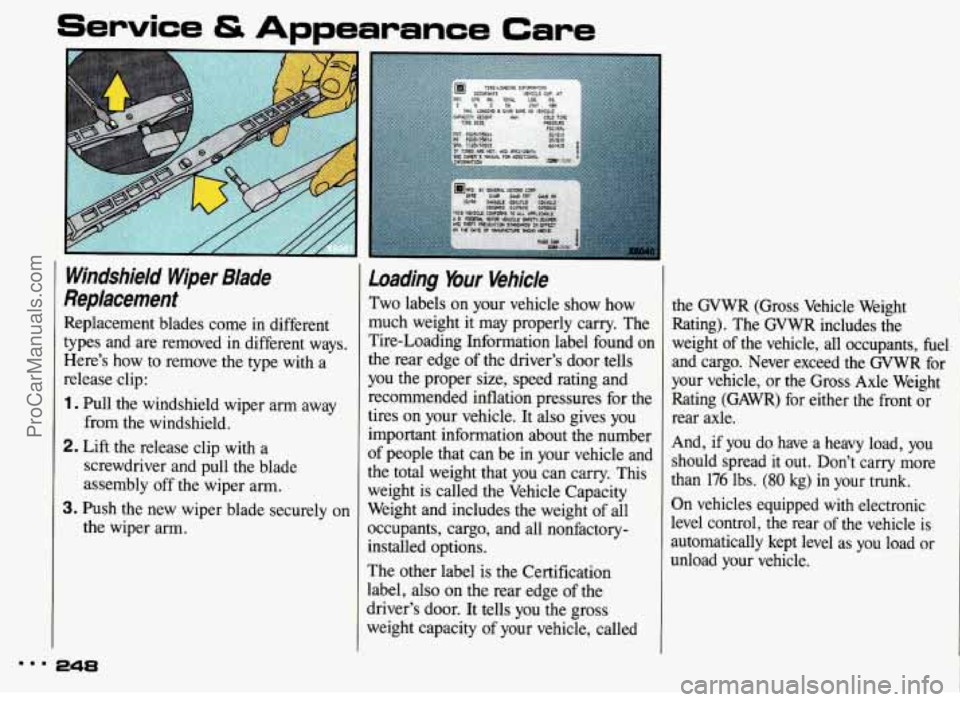
Service & Appearance Care
Windshield Wiper Blade
Replacement
Replacement blades come in different
types and are removed
in different ways.
Here’s how to remove the type with a
release clip:
1. Pull the windshield wiper arm away
2. Lift the release clip with a
from
the windshield.
screwdriver and pull the blade
assembly off the wiper arm.
the wiper arm.
3. Push the new wiper blade securely on
Loading bur Vehicle
Two labels on your vehicle show how
much weight it may properly carry. The
Tire-Loading Information label found on
the rear edge of the driver’s door tells
you the proper size, speed rating and
recommended inflation pressures for the
tires on your vehicle. It also gives you
important information about the number
of people that can be in your vehicle and
the total weight that you can carry. This
weight is called the Vehicle Capacity
Weight and includes the weight of all
occupants, cargo, and all nonfactory-
installed options.
The other label is the Certification
label,
also on the rear edge of the
driver’s door. It tells you the gross
weight capacity of your vehicle, called the
GVWR (Gross Vehicle Weight
Rating). The GVWR includes the
weight of the vehicle, all occupants, fuel
and cargo. Never exceed the GVWR for
your vehicle, or
the Gross Axle Weight
Rating (GAWR) for either the front or
rear axle.
And, if you do have a heavy load,
you
should spread it out. Don’t carry more
than
176 lbs. (80 kg) in your trunk.
On vehicles equipped with electronic
level control, the rear of the vehicle
is
automatically kept level as you load or
unload your vehicle.
... 248
ProCarManuals.com
Page 265 of 322
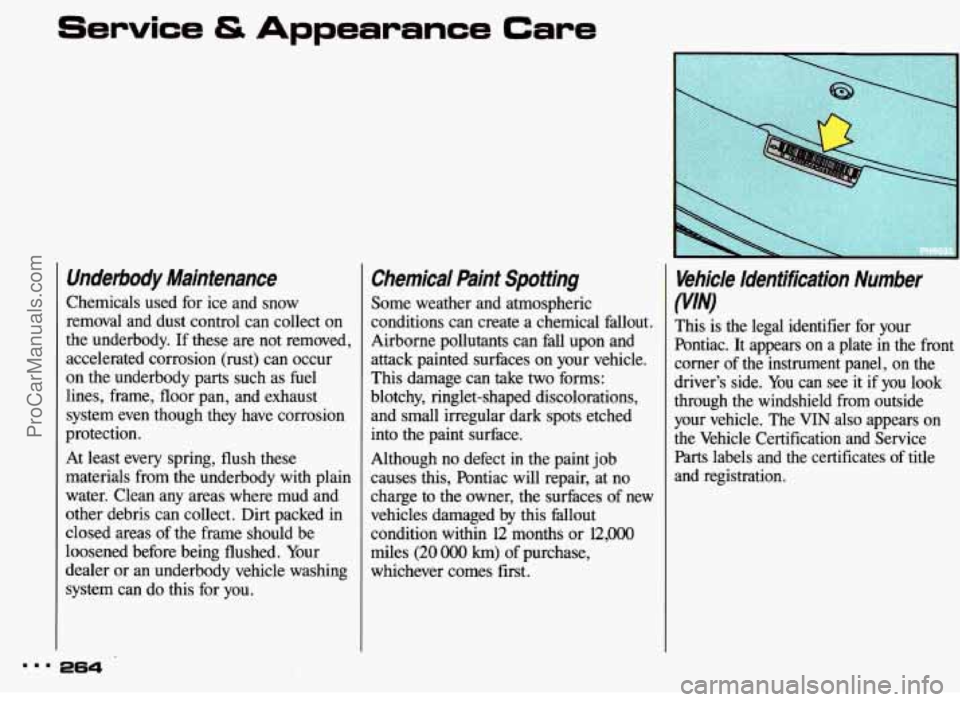
Undenbody Maintenance
Chemicals used for ice and snow
removal and dust control can collect on
the underbody. If these are not removed,
accelerated corrosion (rust) can occur
on the underbody parts such as fuel
lines, frame, floor pan, and exhaust
system even though they have corrosion
protection.
At least every spring, flush these
materials from the underbody with plain
water. Clean any areas where mud and
other debris can collect. Dirt packed in
closed areas of the frame should be
loosened before being flushed. Your
dealer or an underbody vehicle washing
system can do this for you.
Chemical Paint Spotting
Some weather and atmospheric
conditions can create a chemical fallout.
Airborne pollutants can
fall upon and
attack painted surfaces on your vehicle.
This damage can take two
forms:
blotchy, ringlet-shaped discolorations,
and small irregular dark spots etched
into the paint surhce.
Although no defect in the paint
job
causes this, Pontiac will repair, at no
charge
to the owner, the surfaces of new
vehicles damaged by this fdlout
condition within
12 months or l2,OOO
miles (20 0oO km) of purchase,
whichever comes first.
WIN) Vehicle Identification Number
This is the legal identifier for your
Pontiac. It appears on
a plate
in the front
corner
of the instrument panel, on the
driver’s side. You can see it if you look
through the windshield from outside
your vehicle. The VIN
also appears on
the Vehicle Certification and Service
Parts labels and the certificates of title
and registration.
m.. 264
ProCarManuals.com
Page 269 of 322
Service & A .ante Care
Righf Side Fuse Panel Fuses
Additional fuses are located in the relay
(AMP.) center, on the far right side, below the
Position Rating Circuitry
instrument panel. %u must remove the
sound insulator
on the right side of the
passenger
foot well to replace these
fuses.
Replacing these fuses is difficult. We
recommend that you see your dealer if
you need one replaced.
1
2
3
4
5
6
7
8
10
15
15
20
15
20
10
10
A/C Programmer
Fog Lamps
Power Antenna/Door Locks
Horns
Engine Relays and
Miscellaneous Engine
Content
Fuel Pump
Fuel Injectors
Engine Control Module, PASS-KeyTM
Maxifuse/Relay Center
To check the fuses in this underhood
fuse center, turn the two
knobs % turn
counterclockwise and loosen
the metal
wing nut on the passenger side
of the
cover. Then remove the cover. The
inside of the cover has a chart that
explains the features and controls
governed by each fuse and relay.
am. 268
ProCarManuals.com
Page 271 of 322
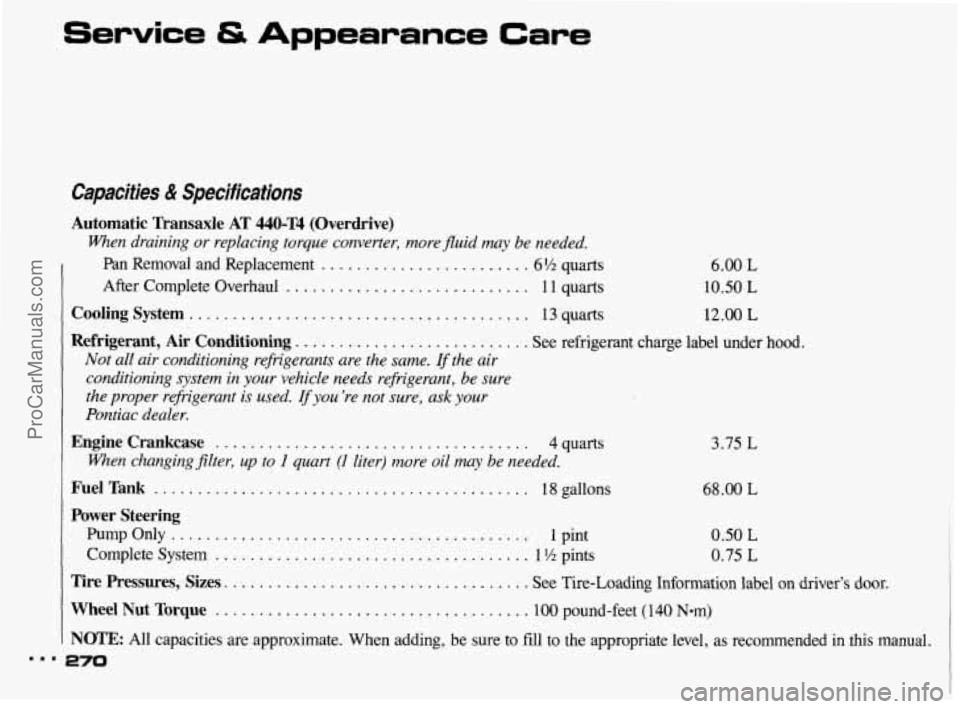
Service & Appearance Care
Capacities & Specifications
Automatic Transaxle AT 440-T4 (Overdrive)
When draining or replacing torque converter, more fluid may be needed.
Pan Removal and Replacement ........................ 6% quarts
After Complete Overhaul
............................ 1 1 quarts
I Cooling System ....................................... 13 quarts
6.00 L
10.50 L
12.00 L
Refrigerant, Air Conditioning ........................... See refrigerant charge label under hood.
Not all air conditioning refrzgerants are the same. If the air
conditioning system in your vehicle needs refiigerant, be sure
the proper refngerant is used.
If you 're not sure, ask your
Pontiac dealer.
Engine Crankcase .................................... 4 quarts
Fuel Tank ........................................... 18 gallons
When changing filter, up to I quart (I liter) more oil may be needed.
3.75 L
68.00 L
Power Steering
Pump Only ......................................... 1 pint 0.50 L
Complete System .................................... 1 !h pints 0.75 L
Tire Pressures, Sizes. .................................. See Tire-Loading Information label on driver's door.
Wheel Nut Torque ..................................... 100 pound-feet (140 Nom)
NOTE: All capacities are approximate. When adding, be sure to fill to the appropriate level, as recommended in this manual.
270 I..
ProCarManuals.com